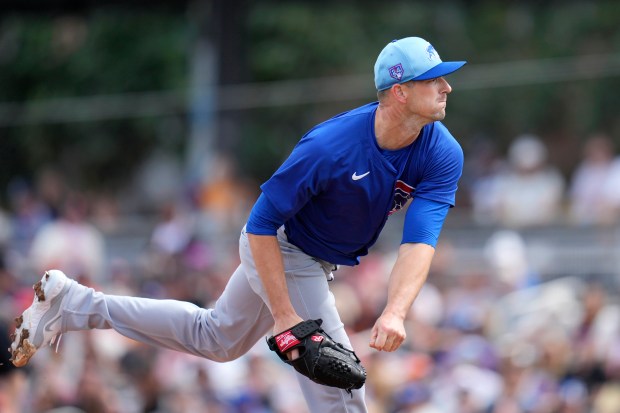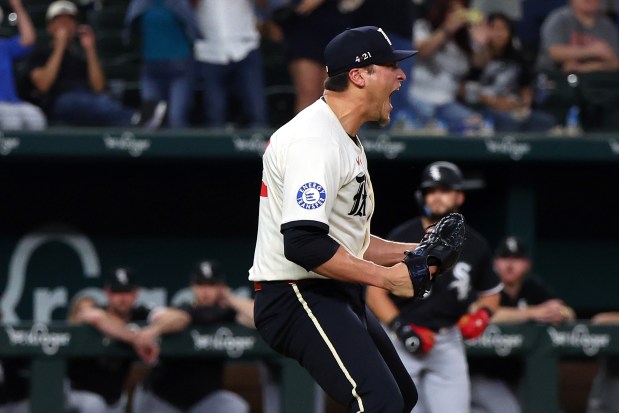MESA, Ariz. — The Chicago Cubs’ starting pitching depth is expected to be a strength this season.
That might be tested soon with 16 days before camp breaks.
Right-hander Jameson Taillon was scratched Saturday with lower back tightness before his scheduled Cactus League debut. His back didn’t feel much better Sunday, prompting manager Craig Counsell to declare that’s “probably not the improvement we were hoping for.”
Taillon likely will undergo more diagnostics and testing to see if the team can learn anything more about his back ailment, though Counsell added it has not yet been determined whether Taillon will undergo an MRI. Counsell acknowledged a level of concern about the injury “for opening day, certainly.”
“Look, I never want to lose players, never wanting to even consider him,” Counsell said. “I don’t think this is a long-term absence for Jamo.”
Injuries are expected, especially to pitchers, over the course of a season. Counsell believes the Cubs are still in good shape as the pitchers in big-league camp who could start or be used out of the bullpen remain stretched out and ready to ramp up.
That group — left-handers Drew Smyly and Jordan Wicks and right-handers Javier Assad and Hayden Wesneski — already was in the mix for the final spot in the rotation. Even before Taillon’s back issue, Counsell had not determined whether any of those four would prepare to help the Cubs out of the bullpen to begin the year.
“We have not ruled anybody out at this point, so we’ll just keep a bunch of guys stretched out and see how that plays out,” Counsell said.
Smyly tossed 3 1/3 shutout innings Sunday against the Texas Rangers, scattering four hits, walking one and striking out four.
“We have a lot of talent in this organization,” Smyly said. “Young guys that might be inexperienced but plenty of talent capable of doing the job, and we have a lot of veteran guys that are capable. So, yeah, I think the Cubs are in a good spot no matter what.
“I did want to come out and try to get results and battle and just be really aggressive toward their lineup. I feel confident and I feel really good where I’m at, regardless of what role I’m pitching in.”
Assad, Wesneski and Smyly all helped the Cubs in both the rotation and spot starts in 2023 and likely will find themselves contributing in both roles again. If Smyly or Wicks begins the year in the rotation, the Cubs would have three lefty starters. Counsell does not seem to have any issues with that.
“Who are the best people to get hitters out? This doesn’t have anything to do with left-handed or right-handed,” Counsell said. “Who’s going to get people out the best? That’s who’s going to pitch.”
As the Cubs work through how they want to build the rotation and pitching staff, the organization wants to maintain starting pitching depth at Triple-A Iowa for when the inevitable injuries or performance issues arise.
It would not be a surprise to see Wesneski open in Iowa’s rotation to remain stretched out and ready. He showed he can be a weapon out of the bullpen and the Cubs aren’t ready to declare any roles yet, but maintaining flexibility with pitcher usage and minor-league options will be part of the consideration.
Counsell has been upfront in communicating how he envisions players’ roles. Wesneski said he was told that if the Cubs are going to be successful, he has to be part of it.
“That’s partly because you need a lot of arms to throw, right?” Wesneski said. “Last year we had 11 guys start and we had a pretty healthy staff. … That was just his message, like: ‘Hey, listen, we want you to start. If we had an opportunity to develop you, we’re here to win games.’
“He values pitching a lot, so I really appreciate that coming from a former hitter.”
Wesneski took two lessons from his 2023 experience into the offseason: He can play in the big leagues — “That’s something that people don’t talk enough about,” he said — and he has found success in whatever role the Cubs need him.
Counsell enjoys watching how young players handle the transition from the minors to the big leagues. For a lot of players, it’s the first time they have ever failed during their baseball career.
“And it comes right after the best moment of your life, so that’s what makes it so hard mentally,” Counsell said.
Counsell considers those challenges a normal part of the process. The timeline is different for every player. Wesneski understands that well.
“The league is just so good that it’s going to present failure to you,” Counsell said. “So for a young guy like Wes, I mean, he also conquered (the majors) early and then experienced the failure kind of thing. So it’s just part of it, and that confidence that you have in yourself is something that you can’t let anybody take away from you.”




